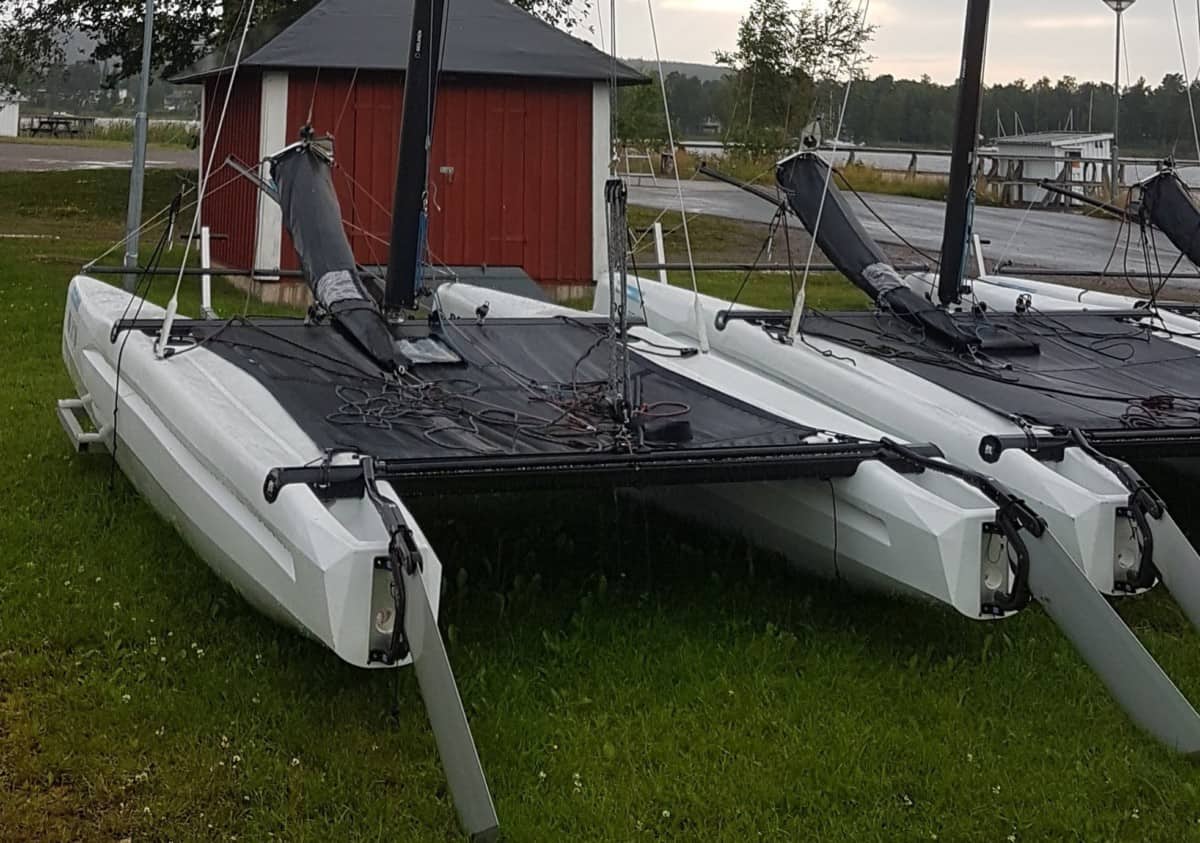As an Amazon Associate, we earn from qualifying purchases. We may also earn commissions if you purchase products from other retailers after clicking on a link from our site.
Learning how to sail a small catamaran(also known as beach cats) can be the beginning of a new and exciting chapter in your life. It gives you the freedom to comfortably explore the waters, which offers a stimulating and relaxing sensation. If you’re interested in learning how to sail, it is advisable to start with a small catamaran.
To sail a small catamaran (beach cat), first, familiarize yourself with the catamaran’s essential parts and common sailing terminologies. Understand how it works and equip yourself with the necessary sailing gear. Additionally, you’ll need to understand the points of sail, how to steer, turn, and stop the cat.
This guide outlines what you need to know about sailing a small catamaran. Read on to learn more on:
- What is a catamaran?
- Understanding how a catamaran works
- Getting equipped
- Sailing basics
Looking to buy a small catamaran? Read my article Best Catamarans For Beginners
Understanding a Catamaran
The first step in learning how to sail a small catamaran is to understand its essentials. We begin by looking at what a catamaran is, its essential features, and some standard sailing terms. Understanding the necessary parts of a cat and sailing terminologies helps with communication when sailing.
What Is a Catamaran?
A catamaran is a famous multi-hulled water vessel that features two parallel hulls and sails. Catamarans vary in size and shape, depending on the model and design. However, here we’re looking at the small catamarans (a.k.a. beach catamarans) and how to sail them.
Parts of a Small Catamaran
Below are the essential parts of a catamaran regardless of its model or design:
- Hull: It is the main body of the cat. It has a symmetrical shape, which reduces the drag caused by water friction.
- Tiller: It is a handle or bar that turns the catamaran’s rudder.
- Rudder: An underwater vertical moving board often turned using a tiller (or steering wheel) to initiate movement.
- Keel: It is a centreline attached below the hull running from the front (bow) to your cat’s back (stern). The keel offers stability to the cat and reduces the chances of it capsizing.
- Mast: A long pole set upright from the center of the boat to support the sails.
- Mainsail: It is the most critical sail on a cat that is attached to the mast.
- Foresail: Also known as the jib. It is a sail that fits into the foretriangle of the mast.
- Boom: This is a horizontal pole attached to the mast used for extending the foot of the mainsail.
A full interactive guide on catamaran parts explained?
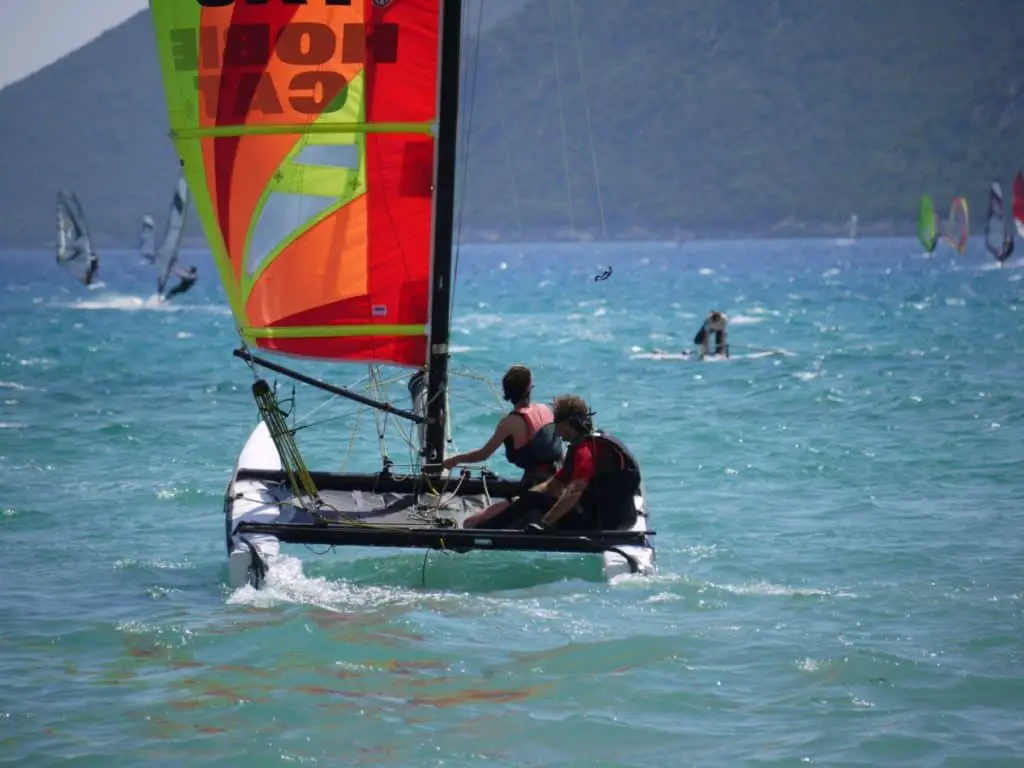
Common Sailing Terminologies
Now let’s look at some terms to add to your sailing vocabulary.
- Point of sail: The direction of your cat relative to the wind.
- Port: When facing forward, your cat’s left side is referred to as the port.
- Starboard: Refers to anything to the right of your cat when you are facing forward.
- Bow/ stern: The front and back of the catamaran, respectively. Additionally, you can refer to the bow as ‘forward’ and the stern as ‘abaft/ aft.’
- Tack: Changing the direction of your cat by turning the bow through the wind.
- Jib (gybe): Turning the stern of your cat through the wind to change direction.
- Heeling: A situation where the wind pushes your cat as it leans over in the water.
- Windward: The side of your catamaran that is closest to the wind. It can also be defined as the direction upwind from the point of reference.
- Leeward: The side of your cat far away from the wind. It is the direction of a cat upwind from the point of reference.
- Aboard: On or within the catamaran
- Halyards: Ropes used in raising or lowering the sails on the mast.
- Sheets: Are ropes that control the angle of the sails relative to the wind’s direction.
Learning How a Small Catamaran Works
After gaining knowledge of parts of a cat and the common sailing terms, the next step is to understand how the catamaran works. Here, we’ll look at how the wind gets your catamaran moving.
As the sail of your small catamaran fills with wind, it forms an airfoil that propels your cat. Your sails play the most significant role in keeping your cat moving. As a result, you have to pay much attention to their positioning relative to the wind.
You start by raising the sails using the halyards. The mainsail (the sail closest to the stern) should be raised first, followed by the jib (the sail closer to the bow). With your sails raised, you should then trim them relative to the direction of the wind. By trimming your sails, you position them at an angle where they capture more wind.
As a newbie, you should first learn raising and trimming the mainsail before the jib because you will use it more when sailing your small catamaran.
However, you should note that you don’t rely solely on the sails and the wind to get your catamaran moving. You should also use the tiller to move and control the rudder. This way, you will be in a position to angle your cat in your preferred direction.
As you continue sailing, the wind’s direction keeps on changing. As a result, you should use sheets to trim your sails while tacking and jibing with respect to the wind’s direction changes.
Getting Equipped
After learning how a catamaran works, you are a step closer to practicing in the waters. However, before this, you need to prepare yourself by getting the right sailing gear. Your instructor should advise you on the right clothes and safety equipment.
Here are some items you should not leave behind:
- Shoes: You’ll need a pair of fitting shoes that you can comfortably use on the deck. They should be grippy and non-marking.
- Gloves: It is also advisable to have quality sailing gloves. They should be comfortable to wear and also allow you to control the tiller and perform other duties on board. Consider getting heavy-duty and breathable gloves.
- Sunglasses: You’ll also need good polarized sunglasses that will protect your eyes from the glare. When learning how to sail, it is essential to see how the water is moving. This helps in learning how to read the wind.
- Windbreaker: Do not forget a piece of clothing that will keep you comfortable even under windy conditions. It should be warm and waterproof.
- Logbook: You’ll also need a book where you can keep all your sailing records. You can indicate how many sailing classes you’ve taken, the number of hours you’ve sailed, and the waters, shallow or deep.
- Compass/GPS: Don’t leave behind a compass and a map. These come in handy when you want to find a bearing or are lost in the sea.
- First aid kit: When packing your essentials, don’t leave behind a first aid kit. As a newbie, you might have sea sickness during your first sailing sessions. Carry a kit with the right prescriptions.
- Finally, do not leave behind a phone and a power bank, plus enough food and water.
After preparing yourself for sailing, you should also prepare your small catamaran.
Preparing the Catamaran
Preparing your beach catamaran for sailing involves analyzing its parts and studying the prevailing weather conditions.
Perform a Physical Check
First up, conduct a detailed physical check to see if all the parts are in their stable working conditions:
- Check if the tiller is moving freely to control the rudder.
- Look at the condition of your sails. Ensure they are straight and with no holes or frayed edges.
- The rigging should be in their perfect working conditions. Check the standing rigging (everything that keeps the mast and sails upright) and the running rigging (the lines used to raise and control the sails).
- Check all lines. They should be free. This means they should not be wrapped against each other or around any objects aboard. Here you may also need to tie line knots if you intend to use them during your sail.
Study the Wind
Before getting into the waters, you’ve to study the direction of the wind. Knowing how the wind is blowing helps in the proper positioning of the sails and the cat. You can check the wind’s direction by looking at wind instruments in your small catamaran.
Most catamarans have wind indicators strategically placed on their mast. You can use this. Additionally, you can tie small flags on the sides of your cat to help with the direction. Knowing where the wind is coming from allows you to position your cat at the right point of sail.
Points of Sail
The point of sail defines the direction of the wind relative to your cat. With the right point of sail, you will be in a position to sail your catamaran smoothly. The point of sail differs depending on the angle of your cat from the wind. The different points of sail include:
- Running: In a running point of sail, the wind blows behind your back. It is not advisable to use this point of sail as accidents are prone to occur if the wind’s force pushes over your small cat.
- Broad reach: The wind is partially at your back and your side (aft quarter).
- Close reach: Here, you are sailing at approximately 60-75 off the wind.
- Beam reach: You position your cat at an angle of 90 of the wind. It is considered the most precise sailing position.
- Close haul: At this point of sail, you are approximately 45-60 off the wind.
Hoisting the Sails
Now that you have already identified the wind’s direction and positioned your cat, the next important thing is hoisting the sails. While hoisting your sails, it is advisable to start with the mainsail.
- To start with, secure the bottom front of the mainsail to the respective shackles on the boom.
- Notice a small line known as an outhaul that attaches the clew (the lower back part of the mainsail) to the boom. Carefully pull it out until the mainsail forms a smooth airfoil allowing wind to blow over it.
- Now pull down the halyard until it stops. You will notice some flapping on the mainsail, which is normal.
- Ensure that the mainsail’s edges are smooth, then attach the halyard on the winch or cleat.
- Now shift to the jib and hoist it. Start by securing its bottom front part to the boom and then follow a process similar to that of hoisting the mainsail.
Start Sailing
As a newbie, you need to ensure you are on a safe sailing point during your practice sessions. Avoid going far into the waters with your small catamaran during your first training sessions.
Also, ensure that you have enough space around you for your catamaran to turn in response to the wind movements. This is to avoid being thrown back into the dock or in the sand by the moving wind.
As you start sailing, you’ll notice the effects of the wind on your cat. As a result, you may need to make a turn through tacking or jibing.
When sailing, always make sure you place yourself at the right point in your catamaran. Sit at the side where the wind is blowing to; the wind should blow from your back. This means you should be on the opposite side of the sail and not beneath it. Sitting on the wrong side might cause your cat to flip over.
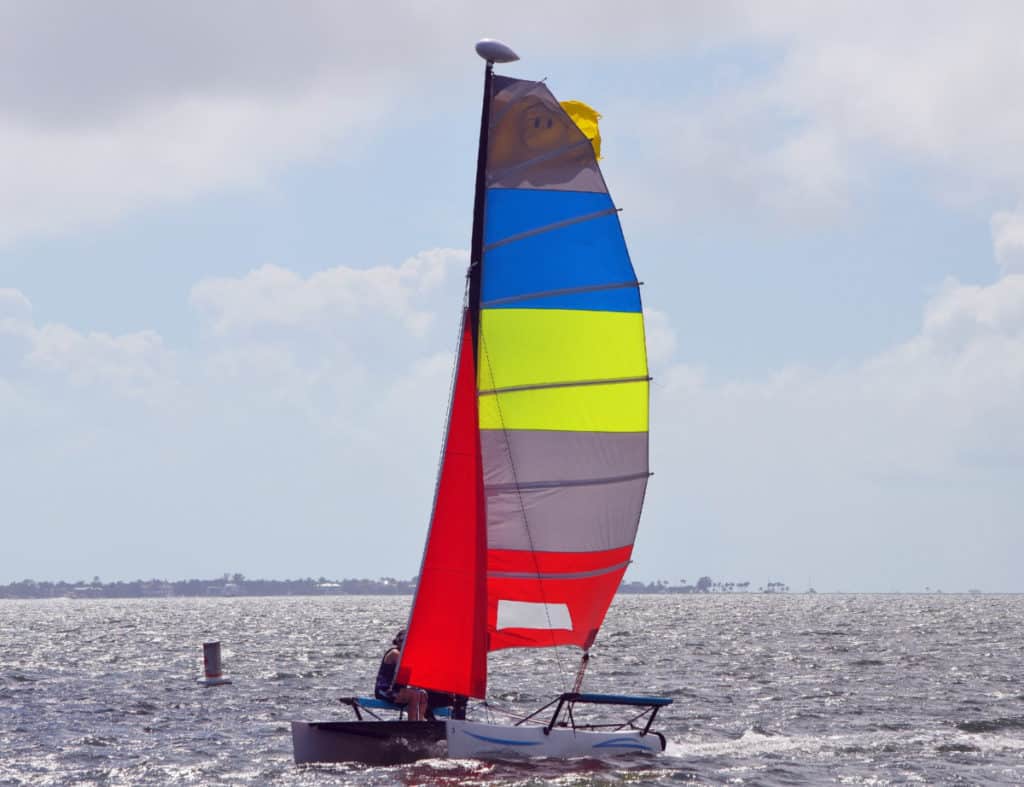
Steering
Now that you already know how to get your cat moving, let’s look at steering. Steering the cat is often unclear to most newbies.
Small catamarans are steered using a tiller that controls the rudder. What confuses most sailors is that you move the tiller in the opposite direction from which you want your cat to move. So, if you’re going to turn to the right, you will push your tiller to the left and vice versa.
Since steering a small cat differs from steering other moving vessels, the experience may feel awkward at first. However, you shouldn’t feel pressured to master it all at once. Take your time and practice until you master the process.
Trimming the Sails
As you continue learning how to sail, you also need to understand how to control your cat by trimming sails. Trimming sails means adjusting the positioning of your sails to control the movement of your cat.
As a learner, to effectively and safely trim your sails, you should first position your tiller to reduce the movement of your cat to either side. Start by trimming the mainsail.
Tighten the mainsail to stop flapping and for it to take a new shape relative to the wind’s direction. As your mainsail takes a new form, your cat will start building some speed. Quickly grab the jib and adjust it too.
To tighten the jib, stretch it as much as you can to reduce flapping/ luffing. Once the flapping has reduced, loosen it and let it out until the edge of its luff (the forward end of the jib) is shaking. Now tighten it back in its new position, and you are ready to go.
If you are sailing close to the wind, you have to keep your sails tighter than usual. On the other hand, if you are sailing off the wind, your sail should be left loose. Generally, tight sails cause your cat to move faster, while the opposite is true for loose sails.
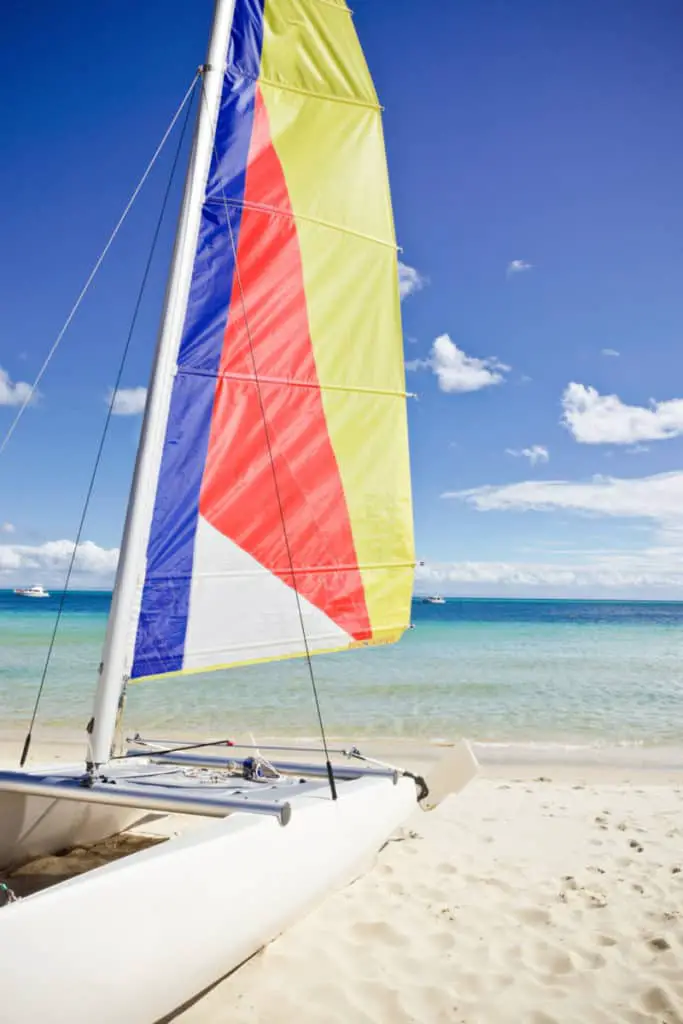
Turning the Catamaran
You’ll also need to learn how to turn a catamaran. As a learner, after releasing the mooring line, you should be prepared to turn the catamaran by moving the boom to either side. As you push out the boom, the wind will hit your sail from the back, making your cat turn.
Therefore, you should be cautious enough to avoid turning in the wrong direction. Like in moving the tiller, you also push out the boom into the opposite direction you want to turn. Therefore, when turning to the right, you push out the boom to the left and vice versa.
Slowing Down and Stopping
Although sailing a small catamaran at high speeds is fun, you may at some point want to slow down. When you detect an obstacle in the water, you may need to slow down. Most sailors use the term ‘spill wind’ to refer to the action of slowing down and stopping a cat.
Since tighter sails often accelerate the speed of your cat, you can slow it down by loosening them a little. The more you let your sails out, the more your cat slows down and eventually stops.
It is advisable to release the sails as you face the wind’s direction to help your cat stop. If you are sailing against the wind, first turn your cat in the direction of the wind, then release the sails.
Practice slowing down and stopping your cat under different weather conditions to be prepared in case of an emergency. Since your cat has no brakes, you should practice this until you perfect your skills.
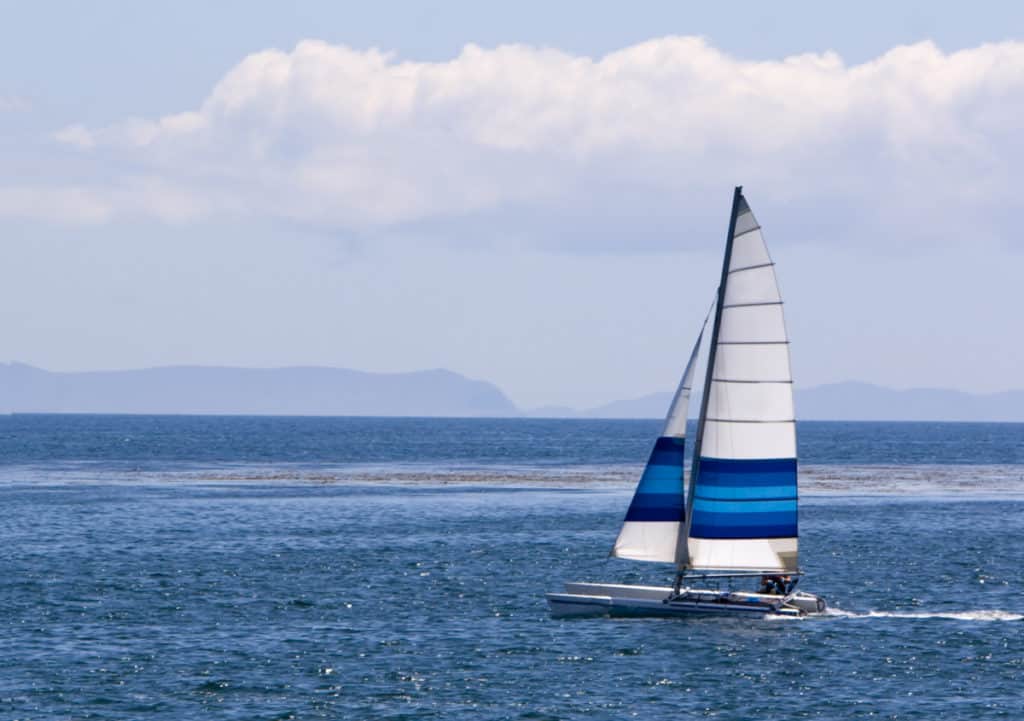
Capsize Recovery
Although capsizing is not common in catamarans, it can happen and it is crucial always to be prepared. If your small catamaran capsizes, it is advisable to start the recovery process immediately before the situation worsens. Let’s look at how to right a capsized catamaran.
Why and how often do catamarans capsize, a scientific approach!
You can right most small catamarans by pushing the bow or stern below the water to rotate them upright.
To right your capsized catamaran:
- Lower down your bow and stern until your cat lies in a vertical position.
- One crew member should then swim around to one end of the lower hull and then push it down. By pushing the lower end down, the uppermost hull’s end comes down towards the water.
- As the uppermost hull drops towards the water, it is pulled down by another crew member. In the meantime, the other crew pushes the cat up midway along the lower hull.
- This movement puts your cat in a vertical position in the water. The crew members then swim to the mast and push it back to its standard sailing position. They then climb aboard fast before the cat sails off.
Avoid sailing alone. Always have some crew members to help you out in case of a capsize.
Conclusion
Learning how to sail a small catamaran is a process that requires practice and patience to perfect your skills. Therefore, don’t feel pressured; take it slow, a step at a time. Start by understanding the essentials of a catamaran, preparing yourself and your cat for the adventure, and learning some sailing basics.
The fundamental sailing basics outlined in this guide are the points of sail, steering, trimming sails, slowing down, and righting a cat after a capsize. Follow our guide today and become a pro in sailing a small catamaran.

